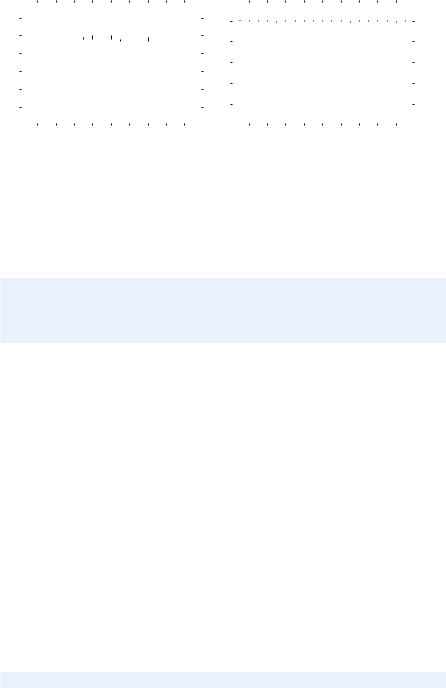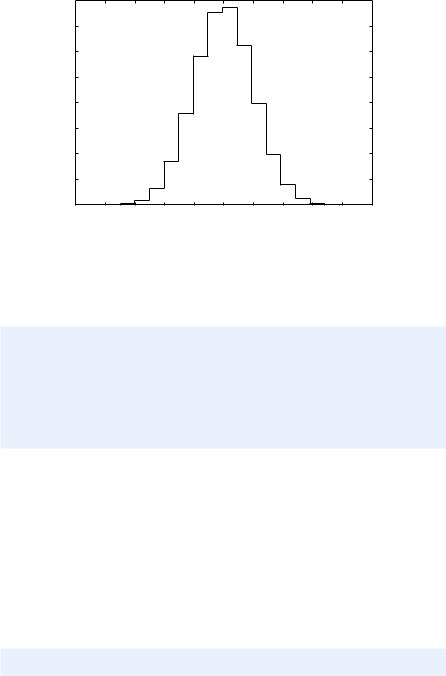
primer_on_scientific_programming_with_python
.pdf

422 |
8 Random Numbers and Simple Games |
|
|
8.1.5 Computing the Mean and Standard Deviation
You probably know the formula for the mean or average of a set of n numbers x0, x1, . . . , xn−1:
|
1 n−1 |
|
|
|
xm = |
|
j |
xj . |
(8.1) |
n |
|
|||
=0 |
|
|
||
The amount of spreading of the xi values around the mean xm can be measured by the variance3,
|
|
1 n−1 |
|
|
|
|||
|
|
|
|
j |
− xm)2 . |
(8.2) |
||
xv = |
n |
|
(xj |
|||||
=0 |
|
|
|
|||||
A variant of this formula reads |
|
|
− xm2 . |
|
||||
xv = n |
xj2 |
(8.3) |
||||||
1 |
|
|
n−1 |
|
|
|
||
|
|
|
j |
|
|
|
||
|
|
|
|
|
||||
|
|
|
|
|
=0 |
|
|
|
The good thing with this latter formula is that one can, as a statistical experiment progresses and n increases, record the sums
q−1 |
q−1 |
|
j |
|
|
sm = xj , sv = |
xj2 |
(8.4) |
=0 |
j=0 |
|
and then, when desired, e ciently compute the most recent estimate on the mean value and the variance after q samples by
xm = sm/q, xv = sv /q − sm2 /q2 . |
(8.5) |
|||
The standard deviation |
√ |
|
|
|
xs = |
|
|
(8.6) |
|
xv |
||||
is often used as an alternative to the variance, because the standard deviation has the same unit as the measurement itself. A common way to express an uncertain quantity x, based on a data set x0, . . . , xn−1, from simulations or physical measurements, is xm ± xs. This means that x has an uncertainty of one standard deviation xs to either side of the mean value xm. With probability theory and statistics one can provide many other, more precise measures of the uncertainty, but that is the topic of a di erent course.
Below is an example where we draw numbers from the uniform distribution on [−1, 1) and compute the evolution of the mean and standard
3Textbooks in statistics teach you that it is more appropriate to divide by n − 1 instead of n, but we are not going to worry about that fact in this book.



8.2 Drawing Integers |
425 |
|
|
1000000 samples of Gaussian/normal numbers on (0,1)
0.4
0.35
0.3
0.25
0.2
0.15
0.1
0.05
0
−5 |
−4 |
−3 |
−2 |
−1 |
0 |
1 |
2 |
3 |
4 |
5 |
Fig. 8.3 Normalized histogram of 1 million random numbers drawn from the normal distribution.
possibility is to draw real numbers from the uniform distribution on, e.g., [0, 1) and divide this interval into four equal subintervals:
import random as random_number r = random_number.random()
if 0 <= r < 0.25: r = 1
elif 0.25 <= r < 0.5:
r = 2
elif 0.5 <= r < 0.75: r = 3
else:
r = 4
Nevertheless, the need for drawing uniformly distributed integers occurs quite frequently, so there are special functions for returning random integers in a specified interval [a, b].
8.2.1 Random Integer Functions
Python’s random module has a built-in function randint(a,b) for drawing an integer in [a, b], i.e., the return value is among the numbers a, a+1, . . ., b-1, b.
import random as random_number
r = random_number.randint(a, b)
The numpy.random.randint(a, b, N) function has a similar functionality for vectorized drawing of an array of length N of random integers in [a, b). The upper limit b is not among the drawn numbers, so if we want to draw from a, a+1, . . ., b-1, b, we must write

426 |
8 Random Numbers and Simple Games |
|
|
from numpy inport random
r = random.randint(a, b+1, N)
Another function, random_integers(a, b, N), also in numpy.random, includes the upper limit b in the possible set of random integers:
from numpy inport random
r = random.random_integers(a, b, N)
8.2.2 Example: Throwing a Die
We can make a program that lets the computer throw a die N times and count how many times we get six eyes:
import random as random_number import sys
N = int(sys.argv[1]) |
# perform N experiments |
|
M = |
0 |
# no of times we get 6 eyes |
for |
i in xrange(N): |
|
outcome = random_number.randint(1, 6) if outcome == 6:
M += 1
print ’Got six %d times out of %d’ % (M, N)
We use xrange instead of range because the former is more e cient when N is large (see remark in Exercise 2.46). The vectorized version of this code can be expressed as follows:
from numpy import random, sum import sys
N = int(sys.argv[1])
eyes = random.randint(1, 7, N)
success = eyes == 6 |
# |
True/False array |
M = sum(success) |
# |
treats True as 1, False as 0 |
print ’Got six %d times out of %d’ % (M, N)
The eyes == 6 construction results in an array with True or False values, and sum applied to this array treats True as 1 and False as 0 (the integer equivalents to the boolean values), so the sum is the number of elements in eyes that equals 6. A very important point here for computational e ciency is to use sum from numpy and not the standard sum function that is available in standard Python. With the former sum function, the vectorized version runs about 50 times faster than the scalar version. (With the standard sum function in Python, the vectorized versions is in fact slower than the scalar version.)
The two small programs above are found in the files roll_die.py and roll_die_vec.py, respectively. You can try the programs and see how much faster the vectorized version is (N probably needs to be of size at least 106 to see any noticable di erences for practical purposes).


428 |
8 Random Numbers and Simple Games |
|
|
deck can alternatively (and more compactly) be done by a one-line list comprehension:
deck = [s+r for s in suits for r in ranks]
We can draw a card at random by
deck = make_deck() card = deck[0]
del deck[0]
# or better:
card = deck.pop(0) # return and remove element with index 0
Drawing a hand of n cards from a shu ed deck is accomplished by
def deal_hand(n, deck):
hand = [deck[i] for i in range(n)]
del deck[:n] return hand, deck
Note that we must return deck to the calling code since this list is changed. Also note that the n first cards of the deck are random cards if the deck is shu ed (and any deck made by make_deck is shu ed).
The following function deals cards to a set of players:
def deal(cards_per_hand, no_of_players): deck = make_deck()
hands = []
for i in range(no_of_players):
hand, deck = deal_hand(cards_per_hand, deck) hands.append(hand)
return hands
players = deal(5, 4)
import pprint; pprint.pprint(players)
The players list may look like
[[’D4’, ’CQ’, ’H10’, ’DK’, ’CK’], [’D7’, ’D6’, ’SJ’, ’S4’, ’C5’], [’C3’, ’DQ’, ’S3’, ’C9’, ’DJ’], [’H6’, ’H9’, ’C6’, ’D5’, ’S6’]]
The next step is to analyze a hand. Of particular interest is the number of pairs, three of a kind, four of a kind, etc. That is, how many combinations there are of n_of_a_kind cards of the same rank (e.g., n_of_a_kind=2 finds the number of pairs):
def same_rank(hand, n_of_a_kind): ranks = [card[1:] for card in hand] counter = 0
already_counted = [] for rank in ranks:
if rank not in already_counted and \ ranks.count(rank) == n_of_a_kind:
counter += 1 already_counted.append(rank)
return counter

8.2 Drawing Integers |
429 |
|
|
Note how convenient the count method in list objects is for counting how many copies there are of one element in the list.
Another analysis of the hand is to count how many cards there are of each suit. A dictionary with the suit as key and the number of cards with that suit as value, seems appropriate to return. We pay attention only to suits that occur more than once:
def same_suit(hand):
suits = [card[0] for card in hand]
counter = {} # counter[suit] = how many cards of suit for suit in suits:
count = suits.count(suit) if count > 1:
counter[suit] = count return counter
For a set of players we can now analyze their hands:
for hand in players: print """\
The hand %s
has %d pairs, %s 3-of-a-kind and
%s cards of the same suit.""" % \ (’, ’.join(hand), same_rank(hand, 2), same_rank(hand, 3),
’+’.join([str(s) for s in same_suit(hand).values()]))
The values we feed into the printf string undergo some massage: we join the card values with comma and put a plus in between the counts of cards with the same suit. (The join function requires a string argument. That is why the integer counters of cards with the same suit, returned from same_suit, must be converted to strings.) The output of the for loop becomes
The hand D4, CQ, |
H10, DK, CK |
|
has 1 pairs, |
0 3-of-a-kind and |
|
2+2 |
cards of |
the same suit. |
The hand D7, D6, |
SJ, S4, C5 |
|
has 0 pairs, |
0 3-of-a-kind and |
|
2+2 |
cards of |
the same suit. |
The hand C3, DQ, |
S3, C9, DJ |
|
has 1 pairs, |
0 3-of-a-kind and |
|
2+2 |
cards of |
the same suit. |
The hand H6, H9, |
C6, D5, S6 |
|
has 0 pairs, |
1 3-of-a-kind and |
|
2 cards of the same suit.
The file cards.py contains the functions make_deck, hand, hand2, same_rank, same_suit, and the test snippets above. With the cards.py file one can start to implement real card games.
8.2.5 Example: Class Implementation of a Deck
To work with a deck of cards with the code from the previous section one needs to shu e a global variable deck in and out of functions. A set of functions that update global variables (like deck) is a primary candidate for a class: The global variables are stored as attributes and

430 |
8 Random Numbers and Simple Games |
|
|
the functions become class methods. This means that the code from the previous section is better implemented as a class. We introduce class Deck with a list of cards, deck, as attribute, and methods for dealing one or several hands and for putting back a card:
class Deck:
def __init__(self):
ranks = [’A’, ’2’, ’3’, ’4’, ’5’, ’6’, ’7’, ’8’, ’9’, ’10’, ’J’, ’Q’, ’K’]
suits = [’C’, ’D’, ’H’, ’S’]
self.deck = [s+r for s in suits for r in ranks] random_number.shuffle(self.deck)
def hand(self, n=1): |
|
"""Deal n cards. Return hand as list.""" |
|
hand = [self.deck[i] for i in range(n)] |
# pick cards |
del self.deck[:n] |
# remove cards |
return hand |
|
def deal(self, cards_per_hand, no_of_players):
"""Deal no_of_players hands. Return list of lists.""" return [self.hand(cards_per_hand) \
for i in range(no_of_players)]
def putback(self, card):
"""Put back a card under the rest.""" self.deck.append(card)
def __str__(self): return str(self.deck)
This class is found in the module file Deck.py. Dealing a hand of five cards to p players is coded as
from Deck import Deck deck = Deck()
print deck
players = deck.deal(5, 4)
Here, players become a nested list as shown in Chapter 8.2.4.
One can go a step further and make more classes for assisting card games. For example, a card has so far been represented by a plain string, but we may well put that string in a class Card:
class Card:
"""Representation of a card as a string (suit+rank).""" def __init__(self, suit, rank):
self.card = suit + str(rank)
def __str__(self): return self.card def __repr__(self): return str(self)
Note that str(self) is equivalent to self.__str__().
A Hand contains a set of Card instances and is another natural abstraction, and hence a candidate for a class:
class Hand:
"""Representation of a hand as a list of Card objects."""
def __init__(self, list_of_cards): self.hand = list_of_cards
